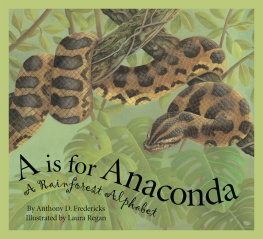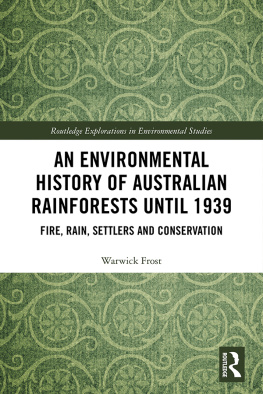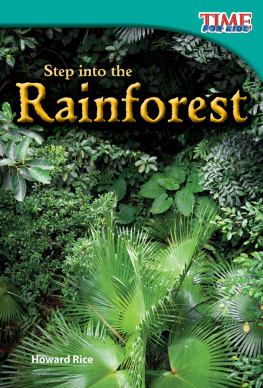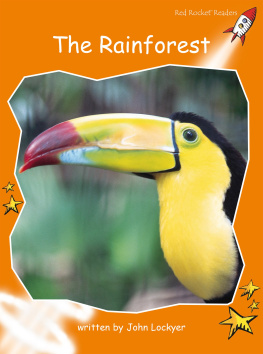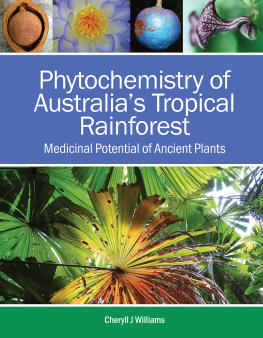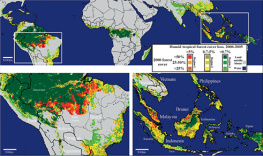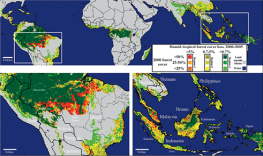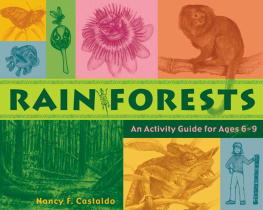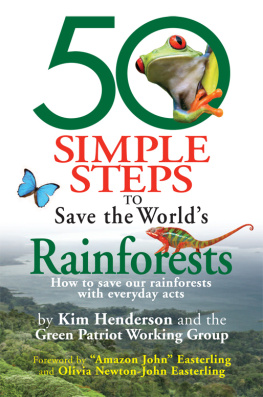
A is for Anaconda
A Rainforest Alphabet

Written by Anthony D. Fredericks and Illustrated by Laura Regan
For Camryn Ohl: Wishing you fantastic discoveries,
incredible adventures, and many magical journeys!
A. D. F.

For my first grandchild, J.Z., with lots of love!
L. R.

Text Copyright 2009 Anthony D. Fredericks
Illustration Copyright 2009 Laura Regan
All rights reserved. No part of this book may be reproduced in any manner
without the express written consent of the publisher, except in the case of brief
excerpts in critical reviews and articles. All inquiries should be addressed to:
Sleeping Bear Press
310 North Main Street, Suite 300
Chelsea, MI 48118
www.sleepingbearpress.com
2009 Sleeping Bear Press is an imprint of Gale.
Printed and bound in China.
10 9 8 7 6 5 4 3 2
Library of Congress Cataloging-in-Publication Data
Fredericks, Anthony D.
A is for anaconda : a rainforest alphabet / written by Anthony D.
Fredericks ; illustrated by Laura Regan.
p. cm.
Summary: Using the alphabet book format the rainforest is explored
and explained. A poem explains each topic followed by detailed
expository text. Topics include Brazil, epiphytes, gorillas, Kapok tree
and nocturnal Provided by publisher.
ISBN 978-1-58536-317-9
1. Rain forest animals Juvenile literature. 2. Alphabet books.
I. Regan, Laura, ill. II. Title.
QL112.F73 2009
591.734--dc22 2008037600
A
Watch out! Look closely and youll see one of the longest snakes in the worldthe powerful anaconda. A full grown anaconda snake can be very big. The longest recorded anaconda was 28 feet (8.5 m) long. Thats longer than a car! That specimen had a girth of 44 inches (112 cm) and weighed nearly 500 pounds (227 kg). Anacondas belong to a group of snakes known as constrictors. When they capture their prey, they wrap their bodies around the victim and slowly squeezetighter and tighter. The victim is unable to breathe and eventually suffocates. Then, the anaconda unhinges its jaw and swallows the victim whole. Anacondas have been known to swallow large animals such as deer and jaguars. They are frequently found in the rainforests of South America.
A also stands for Australia. Australian rainforests are home to some of the most distinctive animals and plants in the world. Although some of Australias rainforests have been destroyed by burning, road building, and real estate development, many are protected in state and national parks.
A is for Anaconda, its sizea scary feature. It swims and slips through rivers deep, and eats most any creature.

B
Brazil is the largest country in South America. It is over 3,300,000 square miles (8,500,000 sq km)the United States is 3,500,000 square miles (9,300,000 sq km) and Canada is 3,800,000 square miles (9,400,000 sq km). More than 172 million people live in Brazil. Consisting of dense forests, semiarid scrub land, rugged moun tains, rolling plains, and a long coastal strip, Brazils landmass is dominated by the Amazonian rainforest. The Amazon River, which is more than 4,000 miles (6,400 km) long, flows eastward through Brazil and empties into the Atlantic Ocean.
Bromeliads begin with B. These are plants that grow in both the understory and can opy layers of the rainforest. They live on the branches and trunks of many trees. They have developed a unique way of obtaining water and nutrients. Most bromeliads have long curved leaves that overlap at the base forming a tight bowl at the bottom. This bowl collects falling rainwater, sometimes as much as 2 gallons (7.58 liters). These pools of water are home to many varieties of animals such as frogs, insects, worms, and spiders.
B is for Brazil, a land both wild and freethe Amazon winds through it, from the Andes to the sea.
C
The canopy layer is one of the four layers of the tropical rainforest. From bottom to top the layers include the forest floor, the understory (a dark layer with slow-growing plants), the canopy, and the emergent layer (which includes the heads of the tallest treesthose 200 feet [61 m] tall or more). Filled with sights, sounds, and colors, the canopy layer of the rainforest is truly amazing. Most of the animals and plants of the rainforest live in this layer. Swinging monkeys, swooping birds, climbing frogs, and lazy sloths make their way through the thick vegetation. Here, the trees are 65 to 100 feet (20 to 30 m) tall.
Chicle [CHEE-kluh] also starts with C. Chicle is the gum from the chicle tree, a tropical evergreen tree. For years it was used as the basic ingredient in chewing gum. It was harvested in much the same way as latex is tapped from rubber trees. Today chewing gum is made from artificial ingredients rather than chicle.
C is for the Canopy, a layer filled with sounds of squawking birds and monkeys wilda place where life abounds.
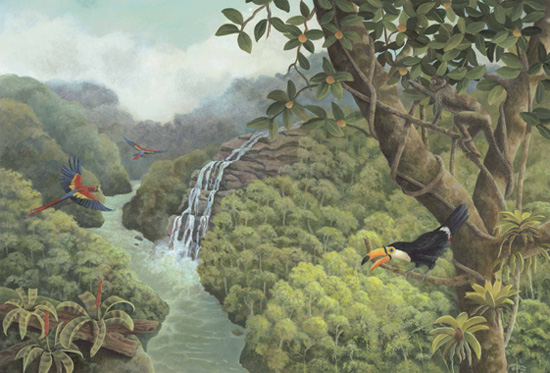
D
Dispersers are animals that scatter plant seeds throughout the rainforest. Many creatures live on a diet of tropical fruits, including the seeds. As these animals travel through the forest, they disperse, or spread, the seeds with their wastes. The seeds often grow into new plants, thus ensuring the survival of the plant species as well as the diversity of life in this fragile ecosystem. There are various kinds of dispersers in the rainforest. These may include bats, monkeys, insects, and a wide range of mammals such as tapirs, ago utis, and lemurs. In most rainforests, birds are the primary seed dispersers.
D is also for deforestation. Once, rainforests covered about 14 percent of the earths surface; today they cover a mere 6 percent. Most rainforests are cleared for their timber. The loss of treesdeforestationhas a signifi cant impact on many animal species. Most rainforests are cleared using chainsaws, bull dozers, and fires. Unbelievably, more than 200,000 acres (80,000 ha) of rainforest are burned every daythats 78 million acres (31 million ha) every year! Some scientists estimate that at the current rate of deforestation, the worlds remaining rainforests could be consumed in less than 50 years.
D is for Dispersers who eat and spread the seeds. They help the forest thrive, providing for its needs.
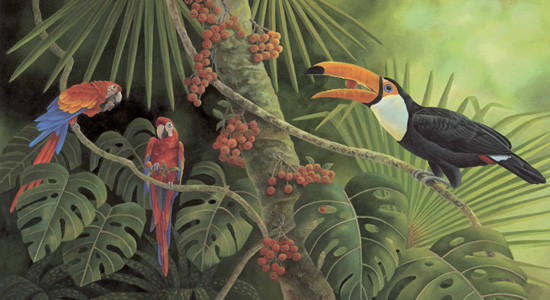
E
An epiphyte [EP-uh-fite] is a plant that grows on the branches or trunks of other plants. These rainforest plants typically have no roots; they take their food and water from the surrounding atmosphere. In short, these plants do not need soil to grow and thrive. Epiphytes are also known as air plants since they grow so high in the trees. Some epiphytes have roots that absorb water right from the air and some are able to store water in a small cup in the center of the plant. They obtain nutrients from litter that falls from the trees or the dust dissolved in rainwater. Some mosses and ferns are epiphytes.
Next page
